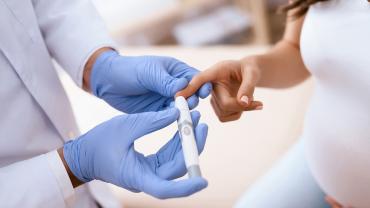
Pregnant women are prone to insulin resistance due to normal physiological adaptations to support the fetus. Exposure to certain chemicals may increase the challenge of controlling blood glucose.
Perfluoroalkyl and polyfluoroalklyl substances (PFAS) are man-made chemicals containing multiple fluorine atoms. These PFAS commonly contaminate individual’s blood.
Observational studies have linked PFAS to impaired glycemic control in the general population. Now scientists are evaluating the effects of exposure to PFAS on blood glucose during pregnancy.
Where are the Chemicals in PFAS Found?
PFAS have been in use since the 1950s. These chemicals provide nonstick, stain-resistant, and water-resistant characteristics to products. We are exposed to PFAS by using items treated with the chemicals and through environmental contamination.
Common sources of exposure to PFAS include:
Contaminated drinking water
Fish from contaminated water
Contaminated soil or dust
Grease-resistant food wrappers and boxes
Microwave popcorn bags
Nonstick cookware and cooking utensils
Stain-resistant carpet and upholstered furniture
Personal care products, such as some dental floss and some hair conditioners
Water-repellant apparel, including some jackets and shoes
Cosmetics, such as some eye makeup and nail polishes
Outdoor equipment, such as tents
Some traditional PFAS have been phased out of production in the U.S. and have been replaced with alternative versions. However, other countries still manufacture and use the older PFAS, and consumer goods made with the chemicals are still imported into the U.S. to be sold.
Unfortunately, most PFAS don’t break down and are very persistent in the environment. Therefore, they are known as “the forever chemicals.” In addition, safety is uncertain with newer replacement types of these PFAS.
Linking PFAS to Elevated Blood Glucose in Pregnancy
Two recent observational studies looked at the association between PFAS and blood glucose levels in pregnancy. Both studies suggested that higher exposure to PFAS may impair glucose homeostasis in pregnant women, which supports the growing body of evidence in this area.
One of the studies included 981 pregnant Chinese women. It found that higher levels of PFAS in pregnant women’s blood were associated with an increased risk of high 1-hour post-challenge blood glucose levels in the second trimester. This was even found in pregnant women without gestational diabetes or weight control issues.
In the other study, control of blood glucose levels in 874 pregnant, nondiabetic Chinese women in their second trimester was compared with levels of PFAS in umbilical cord blood at delivery. Certain PFAS, including some newer options, were associated with elevated post-challenge and fasting blood glucose levels.
Risks Associated with Elevated Blood Glucose in Pregnancy
Gestational diabetes is one risk of impaired blood glucose control during pregnancy. However, even if a woman doesn’t meet the criteria for gestational diabetes, a disruption of glucose homeostasis in pregnancy may result in:
An increased risk of preeclampsia
A greater likelihood of needing a cesarean section
A higher risk of childhood obesity in offspring
An increased chance that offspring will have glucose intolerance in adulthood
Limiting exposure to PFAS is a reasonable precaution for blood glucose concerns in pregnancy. Detoxification may be considered prior to pursuing pregnancy and may help support normal fertility.
By Marsha McCulloch, MS, RDN, LN